TS Queen Mary
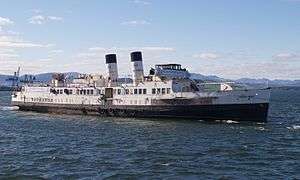 TS Queen Mary arriving back at the Firth of Clyde on 15 May 2016. | |
| History | |
|---|---|
| Name: |
|
| Owner: |
|
| Operator: | (owners) |
| Port of registry: |
Glasgow, |
| Builder: | William Denny and Brothers, Dumbarton |
| Yard number: | 1262 |
| Launched: | 30 March 1933 |
| Out of service: | 1978 |
| Identification: | IMO 5287952 |
| Status: | Under restoration |
| General characteristics | |
| Tonnage: |
|
| Length: | 252.5 ft (77.0 m) |
| Beam: | 35.1 ft (10.7 m) |
| Draught: | 10.1 ft (3.1 m) |
| Installed power: | 350 ihp |
| Propulsion: | 3 Parson Steam Turbines |
| Speed: | 21 knots |
TS Queen Mary is a retired Clyde steamer launched in 1933 and now being preserved as a museum ship. She was built at the William Denny shipyard at Dumbarton for Williamson-Buchanan Steamers. The 871 gross registered ton steamer was powered by three direct drive steam turbines, and carried 2,086 passengers making her the largest (though not the longest) excursion turbine on the River Clyde.
In service
In 1933 she joined the Williamson-Buchanan fleet, taking over from the first Clyde turbine steamer, the 1901 TS King Edward on the run from Glasgow down the River and Firth of Clyde to Rothesay, Millport and Arran. In 1935 the fleet including Queen Mary passed to the London, Midland and Scottish Railway Company, and her registered owners became Williamson-Buchanan (1936) Ltd. Also in 1935, Williamson-Buchanan were contacted by the Cunard Company which was getting ready to have its new liner launched by Her Majesty Queen Mary – so Cunard reached agreement with Williamson-Buchanan that the turbine steamer would become TS Queen Mary II, and presented a portrait of Her Majesty to hang in the forward lounge of the Clyde steamer, while their liner became the RMS Queen Mary.
Queen Mary II was a roomy and comfortable ship, well suited to the large numbers of passengers on the route, with passenger capacity making up for a modest speed of 19.7 knots on trial. She was a two class ship, with cabin passengers housed forward and the top deck extending aft giving steerage passengers a share of it as well as sheltered space below. Though the rest of the fleet was painted in the LMS livery with yellow funnels, she retained her white funnels and Williamson-Buchanan house-flag until World War II.
Wartime and post-war
During the war, she worked on maintaining Clyde services while many other steamers became minesweepers or anti-aircraft vessels. After the war, she returned to service in LMS livery with yellow funnels; then, post war 1948 nationalisation of the railways brought the steamers under the Caledonian Steam Packet Company (CSP) with the same livery. As traffic increased in the 1950s, modifications were made. Over the winter of 1956-1957 the TS Queen Mary II was changed from coal to oil burning, the two funnels were replaced by a single funnel and a new mainmast was added so that she now had two masts to meet changed regulations for ship's lights, with her tonnage increasing to 1014.
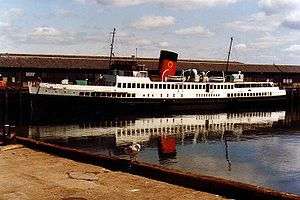
In the 1960s, a gradual change in holiday habits and a succession of summers with poor weather led to a decline in Clyde sailings. While other ships were retired, the Queen Mary II was refitted and put on cruises from Gourock to Inveraray, Brodick and Campbeltown. The CSP had been gradually merging with the west highland ferry company MacBraynes, and in 1973 the company became Caledonian MacBrayne Ltd. After a disappointing first season, they decided to reduce their fleet, with the paddle steamer Waverley being handed to a preservation society, and its routes taken over by the Queen Mary (which lost the "II" as the Cunard liner had by then been retired).
Retirement
Waverley survived and prospered, but with the shift to diesel car ferries and cost pressures the Queen Mary was retired after a last evening showboat cruise from Largs to Rothesay on 27 September 1977. She was then laid up in the East India Harbour, Greenock.

In 1981 the ship was bought by the Lau family and taken south to London to become a floating restaurant but unfortunately it did not do well until 1987 when it was sold to Bass PLC. She underwent a £2.5m refurbishment in 1997 and was moored at Victoria Embankment. Facilities included two bars and two function rooms and the top deck of the ship was used as an open-air venue with bar facilities.
In November 2009, the ship was towed out of London.[1] She was purchased by Samuel Boudon who had plans for her renovation and mooring in La Rochelle, France as a floating restaurant and fitness centre.[2][3] However, she remained moored in Tilbury Docks.[4]
She was auctioned by Capital Marine Services on 24 August 2011,[5] and sold to a British antique dealer planning to restore her to 1930s glory; ″Queen Mary is the last survivor of her class anywhere in the world and is an exceptionally important part of British maritime history epitomising the very best of British shipbuilding pedigree and tradition", ″Our mission is to restore this unique example of British Maritime History″.[6] In 2012 a charitable group, Friends of the TS Queen Mary, was formed with the goal of returning the ship to a permanent berth in Glasgow, Scotland.[7]
In 2013 the ship's owner, Ranjan Chowdhury, was criticised in the media for attempting to sell the ship's remaining brass propellor.[8] By February 2015 Queen Mary was prevented by the Maritime and Coastguard Agency from leaving the Port of Tilbury until made seaworthy.[9]
The Future
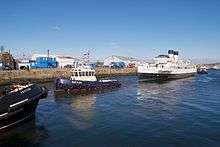
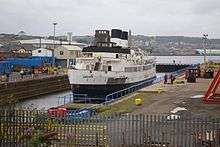
In October 2015 the Glasgow-based charity Friends of TS Queen Mary purchased the ship.[10] In May 2016, after being made seaworthy, the Queen Mary was towed from Tilbury to Garvel Drydock, Greenock, for renovation by Dales Marine, then refit as a floating museum.[11][12]
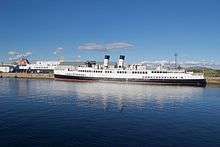
On 1 September 2016 the ship was taken into the dry dock for work on the hull. Considerable progress was made during the month, then the MV Hebrides had to be taken into the dry dock on 1 October for urgent work after colliding with pontoons at Lochmaddy. That day, theQueen Mary was returned to its berth in the James Watt Dock.[13]
See also
References
- ↑ "Tower Bridge site: Bridge Lift Times". Retrieved 2009-11-09. Text included: DAY Mon DATE 09 Nov TIME 14:15 VESSEL TS Queen Mary & Tug DIRECTION Down (meaning down-river)
- ↑ "News - yacht refit". Polerefit.com. 31 January 2010. Retrieved 2 May 2013.
- ↑ "BBC London News: Victoria Embankment has taken a step back into its past with the towing away of the Queen Mary pub boat.". BBC News. 2009-11-08. Retrieved 2009-11-09.
- ↑ Port of London - www.pla.co.uk. "Ships in-port List > Ship Movements > Port Trade". Pla.co.uk. Retrieved 2 May 2013.
- ↑ "Capital Marine Services". Retrieved 1 October 2011.
- ↑ "Welcome to T.S. Queen Mary Website". Retrieved 25 July 2013.
- ↑ "Friends of the TS Queen Mary". Retrieved 13 September 2014.
- ↑ McPherson, Lynn (22 December 2012). "Outcry from marine enthusiasts as propeller belonging to historic Scots ship Queen Mary is put up for sale". Daily Record. Scotland. Retrieved 5 November 2015.
- ↑ http://www.thefreelibrary.com/BLOCKED+IN+DOCK%3B+Blow+as+Coastguard+slap+a+ban+on+bringing+famous...-a0401656798
- ↑ McPherson, Lynn (25 October 2015). "Queen Mary set to return to Scotland as charity led by Robbie Coltrane succeeds in buying legendary steamship". Daily Record. Scotland. Retrieved 5 November 2015.
- ↑ "Garvel Clyde Drydock win contract to repair unique vessel". Greenock Telegraph. 9 April 2016.
- ↑ "Steamer TS Queen Mary set for return to the Clyde". BBC News. 15 May 2016. Retrieved 15 May 2016.
- ↑ "Historic Steamer Looking Shipshape After Dock Work". Inverclyde Now. 1 October 2016. Retrieved 3 October 2016.
Further reading
- Clyde Pleasure Steamers - Ian McCrorie, Orr, Pollock & Co. Ltd., Greenock, ISBN 1-869850-00-9
External links
| Wikimedia Commons has media related to Queen Mary (ship, 1933). |
- TS Queen Mary Official Website
- Queen Mary II information and photographs
Coordinates: 51°27′20″N 0°21′36″E / 51.4556°N 0.3600°E